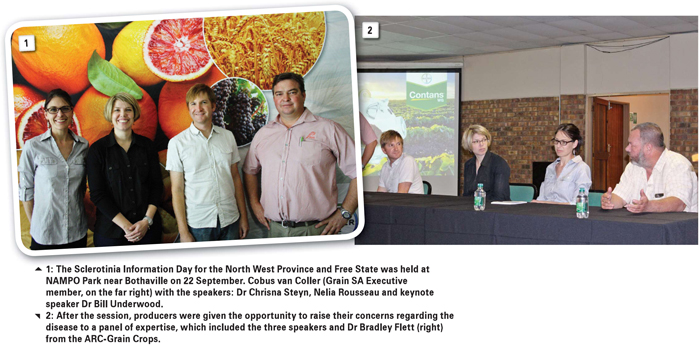December 2017
In response to producers’ rising concern about the impact of Sclerotinia diseases in grain fields, Grain SA and Bayer CropScience joined hands to host three information days in different production areas of the country to share more information about this devastating pathogen.
An American view on Sclerotinia
At each of the events a keynote address was given by Dr Bill Underwood, a plant pathologist from the Agricultural Research Service of the United States Department of Agriculture (USDA-ARS) who has been focussing on Sclerotinia and its effects on sunflower in his research.
According to Underwood environmental conditions strongly influence disease development with little or no disease being observed in some years. Disease inoculum can survive in the soil for more than seven years and is difficult to eradicate once it has established.
Fungicide applications are not very effective in controlling the disease and are affected by time of application as well as coverage. Field trials done in the USA indicate that for most fungicide chemistries that exhibit efficacy against Sclerotinia, application at
R1 (initiation of flowering) is optimal. For most fungicides, adequate coverage seems to be critical and it is important that the fungicide must penetrate the canopy to cover the flowers. Reduced ground speed, increased spray volume and pressure, and the use of nozzles that produce fine to medium droplets can improve coverage and efficacy.
The core focus of the programme to which Underwood contributes is to improve genetic resistance. ‘Be patient, we are working on it,’ Underwood encouraged producers. He mentioned that variation for resistance exists within cultivated germplasm resources and in crop wild relatives. ‘Resistance is however highly polygenic, hindering breeding efforts to incorporate resistance into agronomically favourable varieties.’
A possible solution
No major resistance genes against the disease have been found in hosts, only minor genes with quantitative resistance which only provide varying degrees of tolerance in hosts. This is according to Ms Nelia Rousseau (grower and channel marketing manager: Bayer) who conveyed the news to attendees that a biological agent Contans, which can be applied against the disease, has been developed at Bayer. Contans (Coniothyrium Minitans) is a water dispersible granule biological fungicide designed to control Sclerotinia sclerotiorum and Sclerotinia minor. Rousseau discussed the efficacy and value proposition of the product amongst others.
Dr Chrisna Steyn (Department: Plant Sciences, University of the Free State), a member of the newly established South African Sclerotinia Research Network (SASRN), confirmed that the university is conducting cultivar evaluation to develop a model that will determine the risk percentage of Sclerotinia development on crops. However, with greenhouse and field trials not collaborating, the process remains a challenge.
SASRN is a collective of local researchers working on Sclerotinia and has been formed to prioritise production research, improve collaboration amongst researchers and facilitate collaborative efforts with international researchers. The network will be approaching funding bodies and other stakeholders in an effort to increase research outputs that will ultimately aid producers.

Publication: December 2017
Section: Relevant